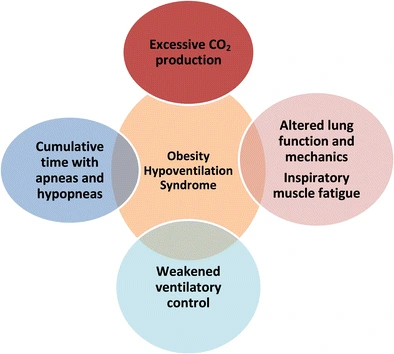Obesity Hypoventilation Syndrome (OHS)
Introduction
Pickwickian syndrome, also known as obesity hypoventilation syndrome, is a breathing disorder that some obese persons have. Both exhaustion and dyspnea are symptoms. A PAP machine and lifestyle modifications are two possible treatment options.
A person with obesity hypoventilation syndrome may have changes in their breathing patterns and the way their brain regulates their breathing. Life-threatening complications may result if treatment is not received.
Hypoventilation does not, however, occur in all obese people.
A lack of fitness alone may not be the cause of dyspnea associated with increased body weight. Shortness of breath and obesity may be signs of lung function abnormalities and underlying inflammation.
An excessive build-up of body fat is called obesity, and it raises your chance of developing diseases including diabetes, heart disease, and high blood pressure.
Breathlessness, or dyspnea, is one of the several symptoms linked to being overweight. While there are numerous reasons for dyspnea, a nationally representative Australian survey conducted in 2022 revealed that almost 25% of all complaints of dyspnea were related to obesity.
The condition known as obesity hypoventilation syndrome (OHS) can be identified when the shortness of breath caused by obesity reaches a certain level of severity.
Is Breathlessness Typical?
Breathing problems are not always caused by serious medical conditions. It is common to have dyspnea during or after exercise. Breathlessness is a common side effect of endurance workouts like walking and aerobics. During activity, muscles need more oxygen to operate.
Prior to entering the bloodstream, oxygen is dispersed and filtered via the lungs and nose. The heart then pumps blood, which gives the body’s muscles oxygen. Your heart and lungs have to work hard when you’re breathing heavily.
Obesity Hypoventilation Syndrome: What is it?
Some obese persons have a breathing condition called obesity hypoventilation syndrome (OHS). Hypercapnia is the condition where your blood contains too much carbon dioxide and not enough oxygen. You typically breathe in oxygen and exhale carbon dioxide. However, you aren’t getting enough air into and out of your lungs when you breathe slowly. Hypoventilation is the term for this.
You might have obstructive sleep apnea, which causes sleep-disordered breathing in addition to hypoventilation. Obstructive sleep apnea accounts for approximately 90% of the sleep-disordered breathing that happens in people with OHS. Thus, OHS usually consists of three components:
- Obesity.
- Hypoventilation.
- Sleep-disordered breathing.
OHS is sometimes referred to as Pickwickian syndrome. In the 1950s, researchers named the illness after a character that exhibited OHS symptoms in a Charles Dickens book.
One of obesity’s major respiratory side effects is obesity hypoventilation syndrome. Although it can lead to potentially fatal health problems, it is curable.
What is the population affected by obese hypoventilation syndrome?
More men are affected by OHS than women. Black people are also more likely than white people to be affected.
How frequently does obesity-induced hypoventilation occur?
It is unknown what the precise OHS rates are. Based on research, however, OHS affects between 0.4% and 0.6% of American adults. This amounts to almost 1 in 260 adult Americans.
Symptoms and Causes
How can obese hypoventilation syndrome manifest itself?
Low blood oxygen levels (hypoxemia) and sleep deprivation are the main causes of the symptoms of obesity hypoventilation syndrome. These signs could consist of:
- Shortness of breath.
- Fatigue.
- Lack of energy.
- Daytime sluggishness.
- Headaches.
- Dizziness.
- Depression.
The following signs could be observed by your bed mate while you’re asleep:
- Loud snoring.
- Choking or gasping.
- Pauses in your breathing.
Why does obesity-induced hypoventilation syndrome occur?
The precise etiology of obese hypoventilation syndrome is unknown. They think it could be a mix of a number of things, such as:
- Your breathing may not be controlled properly if you have a neurological abnormality.
- It may become more difficult for your muscles to breathe deeply and quickly if you have too much weight against your chest wall.
- Hormones that impact breathing patterns may be produced by excess fat on your neck, chest, and abdomen.
How does one diagnose obese hypoventilation syndrome?
To be diagnosed with OHS, a person must fulfill certain requirements. The method includes excluding various illnesses that may cause dyspnea.
Along with talking with you about your symptoms, your doctor will examine you physically. We’ll take into account your head and waist measurements, height, weight, and body mass index (BMI).
Lung testing can help determine how well your lungs are working. It might be necessary to have:
- arterial blood gas test
- fractional exhaled nitric oxide (FeNO) tests
- lung diffusion capacity test
- lung volume test
- spirometry
- pulse oximetry
Diagnostic imaging can be used in conjunction with these lung performance evaluations to help rule out additional disorders that are known to cause dyspnea.
These steps consist of:
- radiographs
- CT scan
- MRI
- bronchoscopy
Your physician can recommend additional tests to guarantee a proper diagnosis, including:
- complete blood count (CBC)
- sleep study
- cardiac studies
OHS is diagnosed when your arterial gas levels are at a certain level, obesity has been verified, and no other conditions can be connected to your symptoms.
WHAT IS THE IMPACT OF OBESITY ON SHORTNESS OF BREATH?
Are you frequently short of breath and wondering if your weight is the cause? You are not by yourself. Many people who suffer from obesity also have respiratory issues. Fortunately, there are things you can do to improve your breathing by learning how weight impacts it. Let’s explain things in plain language.
1. How Breathing Works?
To understand why being overweight or obese impacts breathing, here’s a basic description of how breathing generally works:
Role of Diaphragm: The powerful muscle beneath your lungs is called the diaphragm. It descends as you inhale, drawing air into your lungs.
What Lungs Do: The air that fills your lungs transports oxygen to your blood. When you exhale, the waste gas, carbon dioxide, also leaves your body.
Oxygen to Body: You may then move, work, and think normally since the blood carries this oxygen throughout your body.
When you’re strong and healthy, this process goes easily. Your body may find it more difficult to perform this function if you are overweight.
2. The Impact of Obesity on Breathing?
The way the body breathes is altered by being overweight. How to do it:
The Extra Fat Makes Breathing Difficult
The lungs and diaphragm are compressed when there is excess fat around the chest and belly. Because of this, it is more difficult for your lungs to fully expand during breathing.
When the diaphragm is pressed by the belly fat, it struggles to perform its function.
Greater Oxygen, Greater Body
Larger bodies require more oxygen. For instance, in order to provide oxygen to every muscle and tissue, your heart and lungs must exert more effort. Even while performing basic tasks like walking or climbing stairs, this causes you to feel out of breath.
Tight Airline
Your airways may narrow due to fat around your throat or neck. This can lead to obstructive breathing issues like sleep apnea or snoring because it makes it more difficult for air to pass through the airways.
Other Obesity-Related Health Issues
Sleep Apnea: Due to obstructed airways, this condition causes breathing to pause briefly while you sleep. You may awaken with a rush of breath.
Asthma or Lung Problems: Because obesity increases airway inflammation, breathing problems can get worse.
Heart Problems: Ineffective cardiac function can lower the body’s oxygen supply, leaving you feeling exhausted and short of breath.
3. Symptoms to Watch For
If you have any of these symptoms, it could indicate breathing problems linked to obesity:
- not being able to breathe, even while climbing stairs or strolling softly.
- Feeling like you can’t breathe correctly, making it difficult to lie down.
- Sleep apnea symptoms include snoring or waking up while gasping.
- feeling lightheaded or exhausted even after engaging in minimal activities.
- the sensation of a constricted or wheezing chest.
These should be addressed right away if they occur frequently.
4. Why Should This Be Fixed?
Breathing issues should not be ignored because:
- Daily chores like cooking, working, and playing with children may become more difficult as a result.
- Having trouble breathing can strain your heart and lead to other health problems, such as heart attacks.
- Breathing issues that go untreated over time can harm your lungs or make recovery more difficult.
You can avoid more serious health problems in the road by taking these concerns carefully now.
5. Easy Methods to Get Better
Fortunately, there are a few simple things you may do to begin feeling better:
Visit a Doctor
- The reason for your dyspnea can be determined by a physician. They might recommend tests to examine your breathing or sleep habits.
- If necessary, the doctor might suggest medications or equipment to help you breathe better, such as a CPAP machine (for sleep apnea).
Make Lifestyle Changes
- Lose Weight Gradually: Consuming the proper quantity of nutritious meals can aid in weight loss.
- Add more fruits, vegetables, lean proteins Add foods high in fiber, such as brown rice and roti, and foods like dal to your meals.Limit sugar-filled beverages and junk food.
- Move Daily: Yoga, cycling, and walking are examples of mild physical exercises that might enhance general fitness and breathing. Work your way up from a low starting point. Exercise can also improve your sleep quality and reduce stress.
- Learn Breathing Exercises: Easy breathing techniques that assist strengthen your lungs and facilitate breathing include deep breathing and belly breathing.
- Change Sleeping Position: Sleep using more pillows to raise your head a little. Breathlessness or snoring is lessened and your airways remain open.
Both weight and breathing problems can be decreased by regularly following these instructions.
6. Final Thoughts
Although obesity-related shortness of breath can be frightening, there is hope. Simple changes like eating better, exercising more, and improving your breathing techniques can have a significant impact. Individuals who do health-related action frequently experience improvements in their breathing and general vitality.
Starting is never too late. If your symptoms are causing you anxiety, consult a physician and start down the path to improved health and breathing. Little adjustments made now can result in a simpler and better tomorrow!
Management and Treatment
How is the syndrome of obese hypoventilation treated?
Both weight loss and breathing support are part of the treatment for obesity hypoventilation syndrome.
Treating OHS begins with reaching and maintaining a healthy weight for your body. Losing weight can be all you need to treat problems related to your disease and control your symptoms. You can achieve your objectives by adopting healthy lifestyle choices like the following:
- Consume nutritious food, like that found in the Mediterranean diet.
- Try to be active for 30 minutes each day.
- Create healthy sleeping habits.
To assist you lose weight, your doctor might suggest weight loss surgery, depending on your situation. This could involve an operation like gastric bypass surgery.
Breathing assistance
A specialized mechanical ventilation equipment might be suggested by your healthcare practitioner to aid in your breathing. Your blood oxygen levels will rise at night if you keep your airways open with these non-invasive devices. The equipment gives you air through a tube while you sleep, and you wear a particular mask. Among these gadgets are:
- Continuous positive airway pressure (CPAP): When you breathe in and out, a continuous positive airway pressure is provided by a CPAP machine.
- Bilevel positive airway pressure (often known under the trade name BiPAP®): Higher air pressures are delivered by a BiPAP system during inhalation than during exhalation.
You will rarely require a tracheostomy if a positive airway pressure device is unable to help manage your condition. To assist in breathing, a surgeon creates a hole in your neck that extends to your windpipe through a tracheostomy.
Ways to Make Breathing Easier If You’re Overweight?
Physical training and respiratory rehabilitation may both help you breathe more easily.
Cardiovascular exercises, such as walking, riding exercise bikes or cross trainers, and rowing machines, are used by physiotherapists for respiratory rehabilitation. Additionally, they offer muscle-strengthening exercises and breathing techniques that support erect posture.
You should take action if you experience dyspnea during exercise. It is advised that you have a medical examination and fitness evaluation with your physician prior to beginning any new form of exercise.
Can OHS be treated with what drugs?
OHS has not been found to respond well to any medication.
Bariatric surgery is appropriate for whom?
An approach to treating obesity that has led to problems and health concerns is bariatric surgery.
Using methods to alter the stomach’s architecture, bariatric surgery aims to manage obesity by lowering food consumption. Sleeve gastrectomy and gastric bypass are methods of bariatric surgery.
Significantly obese people who are more than 30–40 kg over their ideal body weight are the target audience for bariatric surgery. To ascertain whether your ideal body weight exists, you might utilize the Body Mass Index (BMI) calculation.
By dividing your height in meters squared by your weight in kilograms, BMI calculates the relationship between your height and weight. Finding your BMI is made simple with the BMI Calculator app. When you enter your height and weight, your BMI will be displayed right away. A person is considered normal if their BMI is less than 25, and obese if it is higher than 30.
Individuals with a high body mass index (BMI) and a number of obesity-related conditions are suggested for bariatric surgery. As mentioned before, symptoms might include shortness of breath, metabolic diseases like diabetes, and poor heart and lung function.
Furthermore, bariatric surgery is the best way to prevent a number of health problems and serious diseases for those who often miss meals and workouts but are unable to lose weight.
Prevention
How might my OHS risk be decreased?
The maintenance of a healthy weight can lower your risk of OHS. Follow your doctor’s instructions and continue using any CPAP or BiPAP that they may have recommended.
Consult your healthcare practitioner if you have an upcoming operation or if you intend to fly. You may be at greater risk for major complications in either of these circumstances.
Prognosis
How long does it take for someone with obese hypoventilation syndrome to live?
Through treatment, OHS symptoms may be lessened or even eliminated. For some people, symptom relief can come from simply reducing weight. Treatment is crucial since it can raise your standard of living. Additionally, it lessens the likelihood of developing more issues. 10% less people die from OHS when they receive early treatment with a breathing apparatus.
Heart and blood vessel problems are among the potentially fatal consequences of untreated OHS. A deficiency of oxygen causes your heart to work very hard. Additionally, you run the danger of dealing with issues brought on by sleep deprivation. In the absence of treatment, your chances of hospitalization rise and your quality of life declines.
Those without therapy have a dismal outlook (prognosis). If left untreated, obesity hypoventilation syndrome usually results in a shorter lifespan. OHS has an 18-month death rate of 23% in patients with underlying medical problems.
What side effects may obese hypoventilation syndrome cause?
If obesity hypoventilation syndrome is not treated, it may result in sleep problems. These issues could consist of:
- Depression.
- Agitation and irritability.
- Increased risk of accidents.
- Issues with sex and intimacy.
Additionally, OHS can result in heart problems such as:
- High blood pressure (hypertension).
- Right-sided heart failure.
- pulmonary hypertension, or elevated blood pressure in the lungs themselves.
Living With When is the right time to visit my doctor?
You ought to consult your physician if:
- You also have additional signs of OHS, including obesity.
- When you pause your breathing or snore loudly, your bed mate notices.
- You’re too exhausted during the day.
Severe respiratory complications from obesity include obesity hypoventilation syndrome. Speak with your healthcare practitioner if you suffer from obesity, respiratory disorders, or other sleep disturbances. Their purpose is to assist. A healthcare professional can identify the best course of action for you if they diagnose you with OHS. Early treatment can help OHS symptoms lessen or perhaps disappear. The disorder can lead to potentially fatal health problems if treatment is delayed. Thus, consult a provider immediately.
Conclusion
If you are fat or overweight, losing weight may make breathing easier. Making minor dietary adjustments and boosting physical exercise will help you reach the reasonable weight loss target of 1 to 2 pounds per week.
When choosing an exercise program, you and your physician should be very careful if you have respiratory issues.
Shortness of breath and obesity are directly related. Gaining too much weight can change the way your lungs work and cause inflammation, which makes breathing much harder.
The diagnosis of obesity hypoventilation syndrome can be made when obesity-related dyspnea exceeds a particular threshold.
When you begin your weight-loss journey, PAP therapies are the first line of treatment. During the time it takes to lose weight safely, PAP can help you breathe more easily.
The state of being obese A breathing disorder called hypoventilation syndrome can strike some obese persons. As a result, blood oxygen levels are too low and carbon dioxide levels are too high.
Sleep apnea is a common complication of obese hypoventilation syndrome. This issue occurs when a person’s breathing stops for a while at night.
Losing weight, exercising frequently, and utilizing a CPAP or noninvasive ventilation machine are all part of the treatment for obesity hypoventilation syndrome. Medication or weight loss surgery may be additional therapeutic choices.
People can discuss any symptoms they are having and the best course of action for their situation with their physician.
FAQs
How does dyspnea result from obesity?
Breathing difficulties result from excess body weight because it raises the stress on the lungs and decreases the expansion of the chest wall.
Is shortness of breath along with fat a sign of a serious illness?
It needs to be assessed since it could indicate heart issues, asthma, or sleep apnea.
Does breathing get better for obese people who lose weight?
Indeed, losing weight eases breathing by lowering lung pressure and enhancing oxygen exchange.
What alterations in lifestyle lessen respiratory problems associated with obesity?
A balanced diet, regular exercise, and stress management are essential for enhancing respiratory health.
When is the right time to consult a doctor about dyspnea caused by obesity?
See a doctor right away if any symptoms worsen or continue, especially exhaustion or chest pain.
Can my breathing improve if I lose weight?
Yes, breathing becomes easier and the pressure on your lungs is lessened if you lose even 5–10% of your present weight.
Is obesity the only factor that causes dyspnea?
No, shortness of breath can also be caused by heart problems, stress, or asthma. The best way to find out the precise cause is to consult a physician.
Will I need to take medication for my respiratory issues?
Not every time. Changes in lifestyle and weight loss may be the solution if your symptoms are modest. But occasionally, your doctor might suggest medications or equipment.
How do I go about doing breathing exercises?
Sit comfortably at the beginning. Using your nose, inhale deeply while allowing your abdomen to rise rather than your chest. Slowly exhale through your mouth. Do this five to ten times each day.
Does the syndrome of obese hypoventilation resolve?
Treatment and weight loss can help reduce or eliminate obesity hypoventilation syndrome symptoms.
How frequently does obese hypoventilation syndrome occur?
Obesity hypoventilation syndrome’s precise prevalence is unclear. According to some research, the syndrome is present in about 10% of individuals who suffer from extreme obesity.
Reference
- Obesity hypoventilation syndrome (OHS): MedlinePlus Medical Encyclopedia. (n.d.). https://medlineplus.gov/ency/article/000085.htm
- Gillette, H. (2023a, May 10). What’s the relationship between obesity and shortness of breath? Healthline. https://www.healthline.com/health/obesity/obesity-and-shortness-of-breath
- Hospitals, S., & Team, H. S. (2024, November 15). Why does obesity cause shortness of breath? Sahyadri Hospital. https://sahyadrihospital.com/blog/why-does-obesity-cause-shortness-of-breath/
- Obesity hypoventilation syndrome. (2025, February 7). Cleveland Clinic. https://my.clevelandclinic.org/health/diseases/24393-obesity-hypoventilation-syndrome
- French, M. (2023, April 28). Everything to know about obesity hypoventilation syndrome. https://www.medicalnewstoday.com/articles/obesity-hypoventilation-syndrome
- India, D., Rayate, N., & India, D. (2024, December 23). How does obesity cause shortness of breath? | DOSS India. Doss India | Center of Excellance for Laparoscopic, Obesity & Hernia Surgery. https://www.dossindia.com/blog/how-does-obesity-cause-shortness-of-breath/
- Admin. (2023c, October 20). Why does obesity cause shortness of breath? Aastha Bariatrics. https://aasthabariatrics.com/why-does-obesity-cause-shortness-of-breath/





One Comment